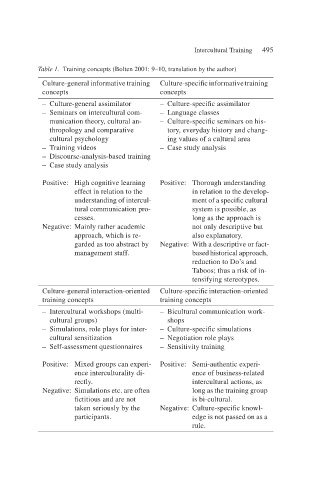Page 517 - Handbooks of Applied Linguistics Communication Competence Language and Communication Problems Practical Solutions
P. 517
Intercultural Training 495
Table 1. Training concepts (Bolten 2001: 9–10, translation by the author)
Culture-general informative training Culture-specific informative training
concepts concepts
– Culture-general assimilator – Culture-specific assimilator
– Seminars on intercultural com- – Language classes
munication theory, cultural an- – Culture-specific seminars on his-
thropology and comparative tory, everyday history and chang-
cultural psychology ing values of a cultural area
– Training videos – Case study analysis
– Discourse-analysis-based training
– Case study analysis
Positive: High cognitive learning Positive: Thorough understanding
effect in relation to the in relation to the develop-
understanding of intercul- ment of a specific cultural
tural communication pro- system is possible, as
cesses. long as the approach is
Negative: Mainly rather academic not only descriptive but
approach, which is re- also explanatory.
garded as too abstract by Negative: With a descriptive or fact-
management staff. based historical approach,
reduction to Do’s and
Taboos; thus a risk of in-
tensifying stereotypes.
Culture-general interaction-oriented Culture-specific interaction-oriented
training concepts training concepts
– Intercultural workshops (multi- – Bicultural communication work-
cultural groups) shops
– Simulations, role plays for inter- – Culture-specific simulations
cultural sensitization – Negotiation role plays
– Self-assessment questionnaires – Sensitivity training
Positive: Mixed groups can experi- Positive: Semi-authentic experi-
ence interculturality di- ence of business-related
rectly. intercultural actions, as
Negative: Simulations etc. are often long as the training group
fictitious and are not is bi-cultural.
taken seriously by the Negative: Culture-specific knowl-
participants. edge is not passed on as a
rule.

